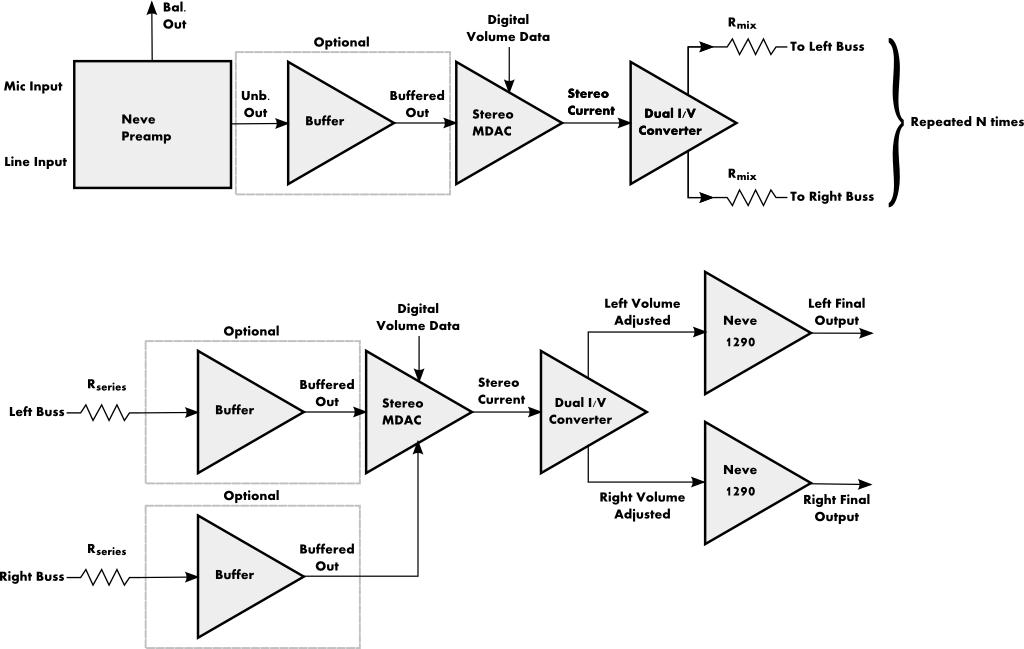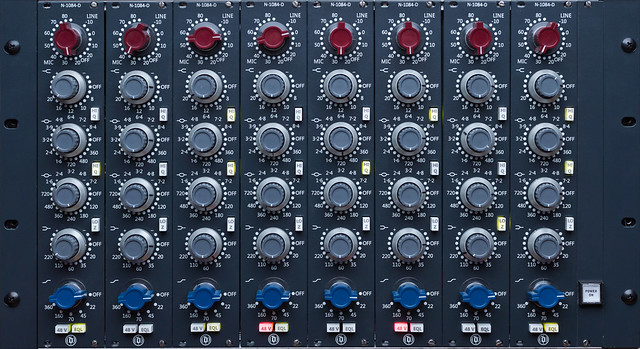You are using an out of date browser. It may not display this or other websites correctly.
You should upgrade or use an alternative browser.
You should upgrade or use an alternative browser.
6U 8 channel Neve mixer
- Thread starter baadc0de
- Start date
Help Support GroupDIY Audio Forum:
This site may earn a commission from merchant affiliate
links, including eBay, Amazon, and others.
Not many,
but here they are, from development
First channel on test. The main (green) PCB is from bruno2000, the small white PCB above it is a local regulator for the channel, phantom power supply and mic input Z relay. The brown PCB on the far right is the PSU for the whole system.
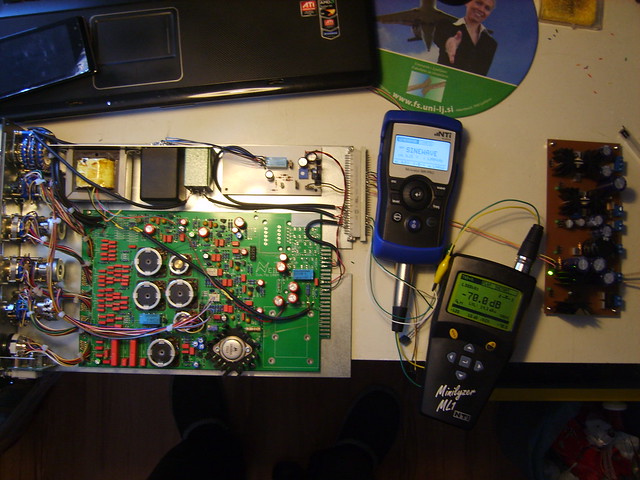
AMI Neve transformers (mic inputs and line outputs, line inputs I scored some original Marinair)
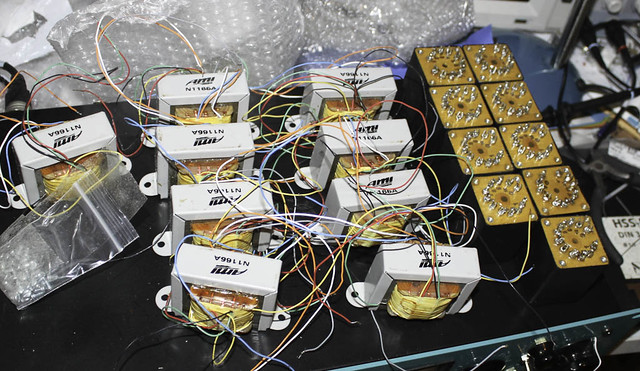
Rear shot of the motherboard with the mixing & summing PCBs. If you squint a bit, you can also see where the D-Subs for mic inputs, line inputs and line outputs go.
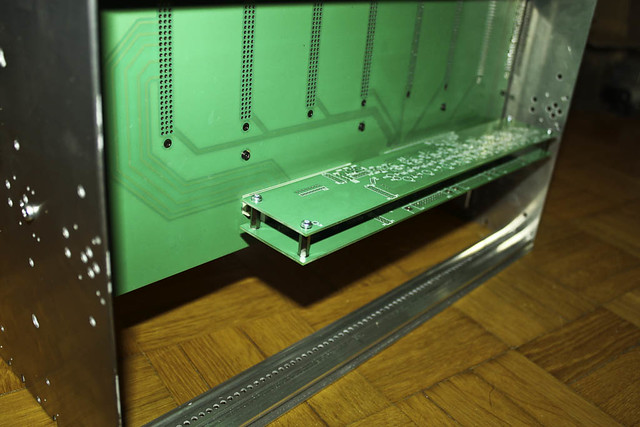
Front view of the (back then) unpopulated motherboard with first channel slid all the way through. Connectors are DIN for Eurocards / VME systems, as is the chassis etc. Eventually there have been more guide rails installed to support the weight of the mixer.
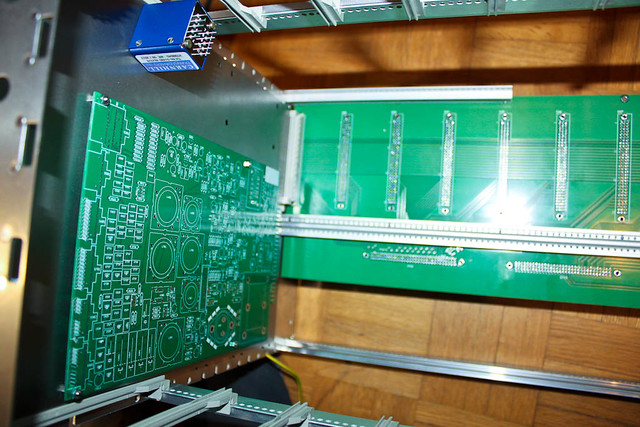
Hope this helps!
but here they are, from development
First channel on test. The main (green) PCB is from bruno2000, the small white PCB above it is a local regulator for the channel, phantom power supply and mic input Z relay. The brown PCB on the far right is the PSU for the whole system.

AMI Neve transformers (mic inputs and line outputs, line inputs I scored some original Marinair)

Rear shot of the motherboard with the mixing & summing PCBs. If you squint a bit, you can also see where the D-Subs for mic inputs, line inputs and line outputs go.

Front view of the (back then) unpopulated motherboard with first channel slid all the way through. Connectors are DIN for Eurocards / VME systems, as is the chassis etc. Eventually there have been more guide rails installed to support the weight of the mixer.

Hope this helps!
Toure14 said:Will you be selling any pcbs, face plates, metal work, and b.o.m? ;D
The PCBs are available from bruno2000. Face plates and L-bracket metal work from diy-racked.com, he has my permission to sell and I think has some reserve plates too that I never got about to needing. Switches are from brett at blore edwards, transformers from oliver at tab funkenwerk... kind of hard for me to sell anything
AudioHammer
Well-known member
Could you draw a block diagram or schematic of the gain control and automation?
Very cool build!
Audiohammer
...
The unblanced out from each channel is taken to a stereo MDAC (an AD5545 /AD4004 combination) where they are multiplied in such a way that the analog signal is the reference voltage and the DAC signal is the set gain constant with 16-bit precision. In this case, the DAC generates just a precise voltage to do (analog) multiplication with.
After this stage, the results are summed in a Neve passive bus kind of way, taken to another stereo MDAC, where master level is controlled and then leaves to the BA283 stages via 31267 transformers. So all signal manipulation and summing is actually analog, just the control bit is digital
Speaking of which, the MDACs are controlled with a Beaglebone (revision 6 I believe) which is a ~700Mhz ARM machine running Linux Angstrom. I have written some software (in Java 7.0! hehe) that is an mDNS responder, an OSC server and RTP node. By using DHCP and mDNS, the machine is put on your LAN and voila, in at most a minute, service discovery is done and it's ready to receive fader and pan set events via OSC or RTP.
Very cool build!
Audiohammer
...
The unblanced out from each channel is taken to a stereo MDAC (an AD5545 /AD4004 combination) where they are multiplied in such a way that the analog signal is the reference voltage and the DAC signal is the set gain constant with 16-bit precision. In this case, the DAC generates just a precise voltage to do (analog) multiplication with.
After this stage, the results are summed in a Neve passive bus kind of way, taken to another stereo MDAC, where master level is controlled and then leaves to the BA283 stages via 31267 transformers. So all signal manipulation and summing is actually analog, just the control bit is digital
Speaking of which, the MDACs are controlled with a Beaglebone (revision 6 I believe) which is a ~700Mhz ARM machine running Linux Angstrom. I have written some software (in Java 7.0! hehe) that is an mDNS responder, an OSC server and RTP node. By using DHCP and mDNS, the machine is put on your LAN and voila, in at most a minute, service discovery is done and it's ready to receive fader and pan set events via OSC or RTP.
AudioHammer
Well-known member
Thanks for the block diagram. 
Is the AD4004 that you mention ADA4004? I can not find AD4004 on the Analog devices website. Do you hear zipper noise on gain or attenuation changes with the MDAC?
Is the AD4004 that you mention ADA4004? I can not find AD4004 on the Analog devices website. Do you hear zipper noise on gain or attenuation changes with the MDAC?
AudioHammer said:Thanks for the block diagram.
Is the AD4004 that you mention ADA4004? I can not find AD4004 on the Analog devices website. Do you hear zipper noise on gain or attenuation changes with the MDAC?
Sorry, AD5545 and ADA4004. There is some zipper noise and we're working on redoing this with optofets and some other ideas we're kicking around to control digital noise. I would sure love to see what SSL did in their Sigma MDAC summing mixer.
r.paige.eo
New member
- Joined
- Aug 26, 2013
- Messages
- 1
Amazing build, and gorgeous too! 
djn111
Well-known member
Hi,
First of all awesome build.
Would you mind sharing the order/part number for the switches ?
Kind regards
First of all awesome build.
Would you mind sharing the order/part number for the switches ?
Kind regards
Slenderchap
Well-known member
This may help with switches:
http://www.audiomaintenance.com/acatalog/Concentric_Switches.html
Colin
www.audiomaintenance.com
http://www.audiomaintenance.com/acatalog/Concentric_Switches.html
Colin
www.audiomaintenance.com
djn111
Well-known member
Thanx Colin,
as always.
DJN
as always.
DJN
Bomper said:Just to check. Are you controlling your faders (aka DAC's or vice versa) from within your DAW? If you are, how does this work? Is there some standard protocol to use?
Insane build by the way!
There is a small oiece of software written on the host computer that translates HUI that get transported to it by midiox or something similar from the daw software. When the fader changes, a hui surface would also need to move the physical fader. We just move the dac fader instead
jplebre
Well-known member
- Joined
- Nov 3, 2012
- Messages
- 617
Sorry to hijack the thread, but if anyone is considering taking the plunge and building this I have 8 PCB's for this project.
It's from a more recent revision than the one used on this project but identical.
My financial and time commitments changed incredibly so I don't see myself starting this for the next 5 to 10 years so I think it's best I give it a better home than my socks drawer
It's from a more recent revision than the one used on this project but identical.
My financial and time commitments changed incredibly so I don't see myself starting this for the next 5 to 10 years so I think it's best I give it a better home than my socks drawer
sharpeleven
Well-known member
jplebre said:Sorry to hijack the thread, but if anyone is considering taking the plunge and building this I have 8 PCB's for this project.
It's from a more recent revision than the one used on this project but identical.
My financial and time commitments changed incredibly so I don't see myself starting this for the next 5 to 10 years so I think it's best I give it a better home than my socks drawer
PM'd
push buttons wìth light are custom or industry ?baadc0de said:
Looks amazing, great work
Similar threads
- Replies
- 6
- Views
- 2K
- Replies
- 0
- Views
- 2K



